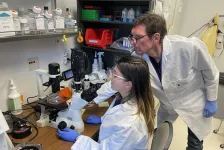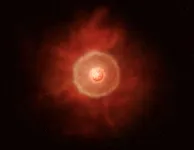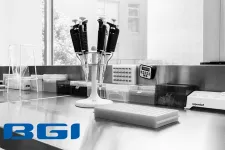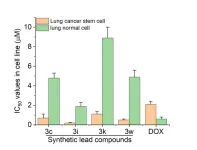(Press-News.org) Researchers at the University of Washington School of Medicine in Seattle have engineered stem cells that do not generate dangerous arrhythmias, a complication that has to date thwarted efforts to develop stem-cell therapies for injured hearts.
“We have found what we have to tackle to make these cells safe,” said Silvia Marchiano, a postdoctoral fellow in the laboratory of Chuck Murry at the UW Medicine Institute for Stem Cell and Regenerative Medicine. Marchiano is the lead author of a paper describing the findings published Thursday, April 6, in the journal Cell Stem Cell. The work was done in collaboration with the Seattle company Sana Biotechnology.
In previous studies, Murry’s team used heart muscle cells created from stem cells to repair heart muscle damage caused by myocardial infarction. This type of heart attack occurs when blood flow to the heart muscle is blocked, thereby causing heart cells to die. Heart cells do not regenerate, so the affected muscle is replaced by scar tissue. This weakens the heart and impairs its ability to pump blood. Severe damage can lead to heart failure and death.
To create their therapeutic heart cells, the Seattle researchers used pluripotent stem cells. Unlike adult stem cells, which have specialized to become specific cell types, pluripotent stem cells can become any type of cell in the body.
From 2012 to 2018 the Seattle team successfully injected pluripotent stem cells into damaged heart walls to create new muscle to replace that lost during an infarction. In animal studies, they showed that the grafted cells would integrate with the heart muscle, beat in synchrony with the other heart cells and improve the heart’s contractility. These findings demonstrated that stem cell therapy could potentially be used to rescue damaged hearts.
But there was one major complication. During the early weeks of engraftment, the hearts tended to beat at a dangerously high rate. Unless a way could be found to prevent or suppress this problem, stem cells could not become a safe treatment for myocardial infarction and heart failure.
“Our goal is to create working contractile cells that would not try to set their own pace,” Murry said.
In the mature heart, the heart rate is regulated by specialized cells called pacemaker cells.These cells generate electric signals at regular intervals that induce the other heart cells to contract.
In pacemaker cells, the voltage cycles back and forth from negative (hyperpolarized) to positive (depolarized). Murry compares it to a metronome with positive ions swooshing in and out of the cell through these channels. The rate at which this cycle of repolarization and depolarization occurs determines the heart rate.
In early embryonic hearts, however, this system, in which relatively few cells have become specialized pacemaker cells while the rest have become quiescent contractile cells, has not developed. All the cells are pacemakers. Murry and his colleagues suspected that the engrafted stem cells were behaving like early embryonic cells chaotically generating signals and causing the dangerous heart rhythms.
To sort out what was causing these cells to behave this way, the researchers used a technique called RNA-sequencing to find out which ion channels were being made at different times as the cells matured. The sequencing revealed that some types of ion channels appear early in development and then disappear as the cell matures while other types of ion channels appear later in development. Like an unfolding mystery, this gave the researchers their list of suspects.
To determine which ion channels were the culprits carrying the arrhythmia-causing current, the scientists used CRISPR-based genome editing to systematically knock out depolarizing genes or to activate repolarizing genes. This proved surprisingly complex. They had hypothesized that there would be a single ion channel causing the arrhythmia, but none of the single-gene edits eliminated the rapid heart rhythms. The researchers then undertook a painstaking process of “playing the combinations” by performing double and triple gene edits. Vexingly, none of these edits eliminated the arrhythmia, and some seemed to make it worse.
Finally, the scientists created a stem cell line in which three depolarizing genes were knocked out and one repolarizing gene was activated. That did the trick. Cardiac muscle cells generated from these stem cells were electrically quiescent, like adult heart muscle, but they contracted when given an electrical signal to mimic a natural pacemaker. The researchers termed these cells “MEDUSA” (for modifying electrophysiological DNA to understand and suppress arrhythmias). The MEDUSA cardiomyocytes engraft in the heart, mature into adult cells, electrically integrate into heart muscle, and beat in sync with natural pacemaking, all without generating dangerous heart rates. This, Murry says, is the sine qua non for heart regeneration.
Murry cautions that additional testing with the engineered cells will need to be done, but, he adds, “I think we’ve overcome the biggest roadblock to regenerating the human heart.”
END
Researchers tackle major obstacle to stem-cell heart repair
Engineered stem cells do not provoke dangerous heart rhythms, a problem that has thwarted development of stem-cell transplants for injured hearts.
2023-04-06
ELSE PRESS RELEASES FROM THIS DATE:
Twinkling stars fuel interstellar dust
2023-04-06
Of the many different kinds of stars, asymptotic giant branch (AGB) stars, usually slightly larger and older than our own sun, are known producers of interstellar dust. Dusty AGBs are particularly prominent producers of dust, and the light they shine happens to vary widely. For the first time, a long-period survey has found the variable intensity of dusty AGBs coincides with variations in the amount of dust these stars produce. As this dust can lead to the creation of planets, its study can shed light on our own origins.
You’ve probably heard of the James Webb Space Telescope (JWST) which ...
The hidden role of food in urban conflicts in Central America
2023-04-06
Extreme water events have been shown to affect human security in many ways. In a research article published today in the new journal Nature Water researchers from Politecnico di Milano and University of California at Berkeley delve deeper into the complex nexus between droughts and conflicts in Central America. For the decades from 1996 to 2016 explore how water availability affects agricultural production and food security, and investigate the nexus between drought-induced food insecurity and the emergence of conflict in the region. Cities in ...
Fasting diet reduces risk markers of type 2 diabetes
2023-04-06
A fasting diet which focuses on eating early in the day could be the key to reducing the risk of developing type 2 diabetes.
Researchers from the University of Adelaide and South Australian Health and Medical Research Institute (SAHMRI) compared two different diets: a time restricted, intermittent fasting diet and a reduced calorie diet to see which one was more beneficial for people who were prone to developing type 2 diabetes.
“Following a time restricted, intermittent fasting diet could help lower the chances of developing type 2 diabetes,” said ...
Optimizing sepsis treatment timing with a machine learning model
2023-04-06
COLUMBUS, Ohio – A new machine learning model that estimates optimal treatment timing for sepsis could pave the way for support tools that help physicians personalize treatment decisions at the patient bedside, researchers say.
In a paper published today (April 6, 2023) in Nature Machine Intelligence, scientists from The Ohio State University describe the new model, which uses artificial intelligence to take on the complex question of when to administer antibiotics to patients with a suspected case of sepsis.
Time is of the essence ...
How to overcome noise in quantum computations
2023-04-06
Researchers Ludovico Lami (QuSoft, University of Amsterdam) and Mark M. Wilde (Cornell) have made significant progress in quantum computing by deriving a formula that predicts the effects of environmental noise. This is crucial for designing and building quantum computers capable of working in our imperfect world.
The choreography of quantum computing
Quantum computing uses the principles of quantum mechanics to perform calculations. Unlike classical computers, which use bits that can be either 0 or 1, quantum computers use quantum bits, or qubits, which can be in a superposition of 0 and 1 simultaneously.
This ...
Archaeology: Evidence of drug use during Bronze Age ceremonies
2023-04-06
An analysis of strands of human hair from a burial site in Menorca, Spain, indicates that ancient human civilisations used hallucinogenic drugs derived from plants, reports a new paper published in Scientific Reports. These findings are the first direct evidence of ancient drug use in Europe, which may have been used as part of ritualistic ceremonies.
Previous evidence of prehistoric drug use in Europe has been based on indirect evidence such as the detection of opium alkaloids in Bronze Age containers, the ...
New test could help identify type 2 diabetes risk
2023-04-06
Analysing changes to DNA in the blood can improve the ability to predict a person’s risk of developing type 2 diabetes within a decade.
Scientists looked at the influence of these changes – known as DNA methylation – alongside other risk factors in almost 15,000 people to predict the likelihood of developing the condition years in advance of any symptoms developing.
The findings could lead to preventative measures being put in place earlier, reducing the economic and health burden caused by type 2 diabetes.
Methylation is a chemical process in the body in which a small molecule called a methyl group is added to DNA.
Current ...
Akili Labs and BGI Genomics to deliver their first commercial clinical sequencing facility in Africa
2023-04-06
JOHANNESBURG, SOUTH AFRICA and SHENZHEN, CHINA - 31.03.23
Akili Labs (Pty) Ltd, a pioneer of cost-effective molecular diagnostics and secure genomic data storage solutions, and BGI Genomics Co. Ltd, the world’s leading integrated solutions provider of precision medicine, today announced the signing of a technology transfer agreement that will provide the Southern region of Africa with clinical-grade sequencing solutions.
"Improving the cost and turnaround time of genetic sequencing services will play a major role in the expansion of precision medicine-driven healthcare in Africa," said Charles F.J. Faul, co-founder ...
Technology advance paves way to more realistic 3D holograms for virtual reality and more
2023-04-06
WASHINGTON — Researchers have developed a new way to create dynamic ultrahigh-density 3D holographic projections. By packing more details into a 3D image, this type of hologram could enable realistic representations of the world around us for use in virtual reality and other applications.
“A 3D hologram can present real 3D scenes with continuous and fine features,” said Lei Gong, who led a research team from the University of Science and Technology of China. “For virtual reality, our method could be used with headset-based holographic displays to greatly improve the viewing angles, which would enhance the 3D viewing experience. ...
Novel tridimensional anticancer agents developed to fight against drug-resistant cancer cells
2023-04-06
A research team co-led by chemists from City University of Hong Kong (CityU) recently discovered novel, highly effective anticancer agents with tridimensional structures, which have high anticancer activity, low toxicity and the ability to overcome drug resistance in cancer cells. The findings help provide a new direction for anticancer drug development.
Cancer has long been a devastating disease, which affects millions of people worldwide. Despite advances in treatment, current anticancer drugs often have limited effectiveness, lack of cancer ...
LAST 30 PRESS RELEASES:
Sleeping in on weekends may help boost teens’ mental health
Study: Teens use cellphones for an hour a day at school
After more than two years of war, Palestinian children are hungry, denied education and “like the living dead”
The untold story of life with Prader-Willi syndrome - according to the siblings who live it
How the parasite that ‘gave up sex’ found more hosts – and why its victory won’t last
When is it time to jump? The boiling frog problem of AI use in physics education
Twitter data reveals partisan divide in understanding why pollen season's getting worse
AI is quick but risky for updating old software
Revolutionizing biosecurity: new multi-omics framework to transform invasive species management
From ancient herb to modern medicine: new review unveils the multi-targeted healing potential of Borago officinalis
Building a global scientific community: Biological Diversity Journal announces dual recruitment of Editorial Board and Youth Editorial Board members
Microbes that break down antibiotics help protect ecosystems under drug pollution
Smart biochar that remembers pollutants offers a new way to clean water and recycle biomass
Rice genes matter more than domestication in shaping plant microbiomes
Ticking time bomb: Some farmers report as many as 70 tick encounters over a 6-month period
Turning garden and crop waste into plastics
Scientists discover ‘platypus galaxies’ in the early universe
Seeing thyroid cancer in a new light: when AI meets label-free imaging in the operating room
Neutrophil-to-lymphocyte ratio may aid risk stratification in depressive disorder
2026 Seismological Society of America Annual Meeting
AI-powered ECG analysis offers promising path for early detection of chronic obstructive pulmonary disease, says Mount Sinai researchers
GIMM uncovers flaws in lab-grown heart cells and paves the way for improved treatments
Cracking the evolutionary code of sleep
Medications could help the aging brain cope with surgery, memory impairment
Back pain linked to worse sleep years later in men over 65, according to study
CDC urges ‘shared decision-making’ on some childhood vaccines; many unclear about what that means
New research finds that an ‘equal treatment’ approach to economic opportunity advertising can backfire
Researchers create shape-shifting, self-navigating microparticles
Science army mobilizes to map US soil microbiome
Researchers develop new tools to turn grain crops into biosensors
[Press-News.org] Researchers tackle major obstacle to stem-cell heart repairEngineered stem cells do not provoke dangerous heart rhythms, a problem that has thwarted development of stem-cell transplants for injured hearts.






